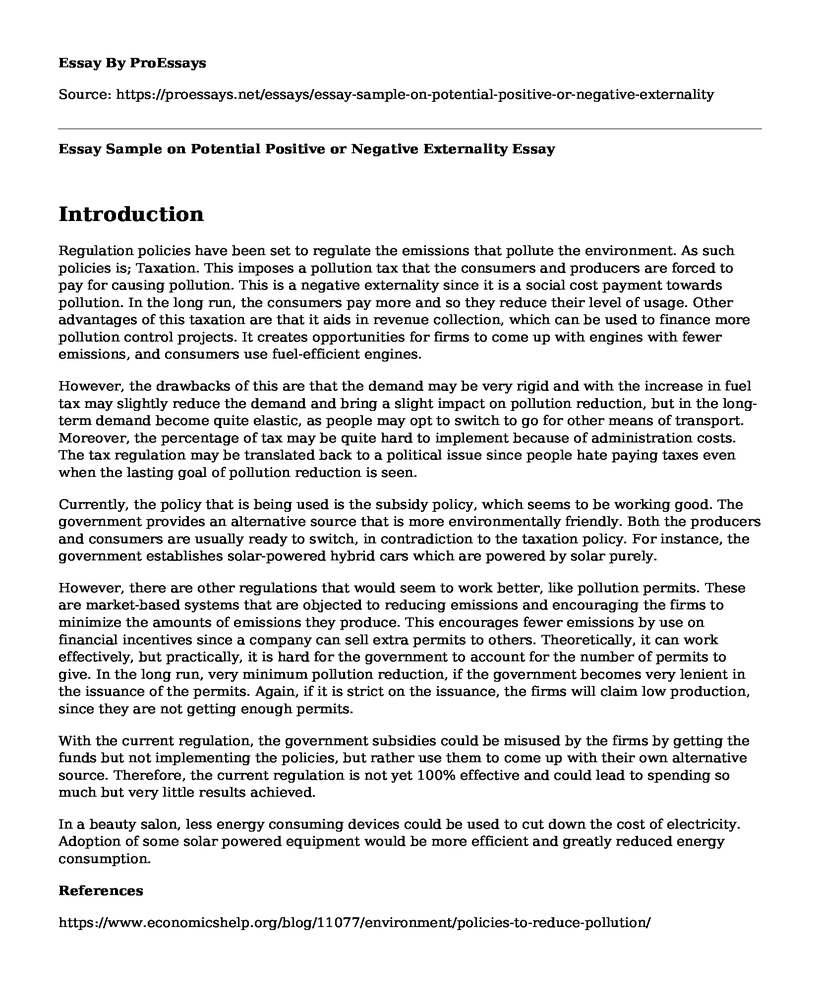Introduction
Regulation policies have been set to regulate the emissions that pollute the environment. As such policies is; Taxation. This imposes a pollution tax that the consumers and producers are forced to pay for causing pollution. This is a negative externality since it is a social cost payment towards pollution. In the long run, the consumers pay more and so they reduce their level of usage. Other advantages of this taxation are that it aids in revenue collection, which can be used to finance more pollution control projects. It creates opportunities for firms to come up with engines with fewer emissions, and consumers use fuel-efficient engines.
However, the drawbacks of this are that the demand may be very rigid and with the increase in fuel tax may slightly reduce the demand and bring a slight impact on pollution reduction, but in the long-term demand become quite elastic, as people may opt to switch to go for other means of transport. Moreover, the percentage of tax may be quite hard to implement because of administration costs. The tax regulation may be translated back to a political issue since people hate paying taxes even when the lasting goal of pollution reduction is seen.
Currently, the policy that is being used is the subsidy policy, which seems to be working good. The government provides an alternative source that is more environmentally friendly. Both the producers and consumers are usually ready to switch, in contradiction to the taxation policy. For instance, the government establishes solar-powered hybrid cars which are powered by solar purely.
However, there are other regulations that would seem to work better, like pollution permits. These are market-based systems that are objected to reducing emissions and encouraging the firms to minimize the amounts of emissions they produce. This encourages fewer emissions by use on financial incentives since a company can sell extra permits to others. Theoretically, it can work effectively, but practically, it is hard for the government to account for the number of permits to give. In the long run, very minimum pollution reduction, if the government becomes very lenient in the issuance of the permits. Again, if it is strict on the issuance, the firms will claim low production, since they are not getting enough permits.
With the current regulation, the government subsidies could be misused by the firms by getting the funds but not implementing the policies, but rather use them to come up with their own alternative source. Therefore, the current regulation is not yet 100% effective and could lead to spending so much but very little results achieved.
In a beauty salon, less energy consuming devices could be used to cut down the cost of electricity. Adoption of some solar powered equipment would be more efficient and greatly reduced energy consumption.
References
https://www.economicshelp.org/blog/11077/environment/policies-to-reduce-pollution/
Cite this page
Essay Sample on Potential Positive or Negative Externality. (2022, Dec 02). Retrieved from https://proessays.net/essays/essay-sample-on-potential-positive-or-negative-externality
If you are the original author of this essay and no longer wish to have it published on the ProEssays website, please click below to request its removal:
- Democracy, Civil Society and Governance
- The War Room Essay Example
- Policies of Social Media in India Paper Example
- DNP Nursing - Essay Sample
- Nelson Mandela Contribution to the Anti-Apartheid Movement
- Essay Example on Living Constitution: Preservation of U.S Constitution.
- Paper Example on Public Policy: A Guide to Governmental Decision-Making







